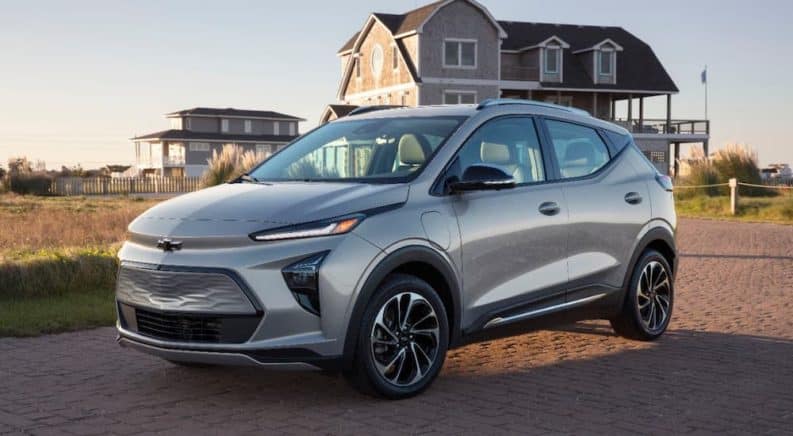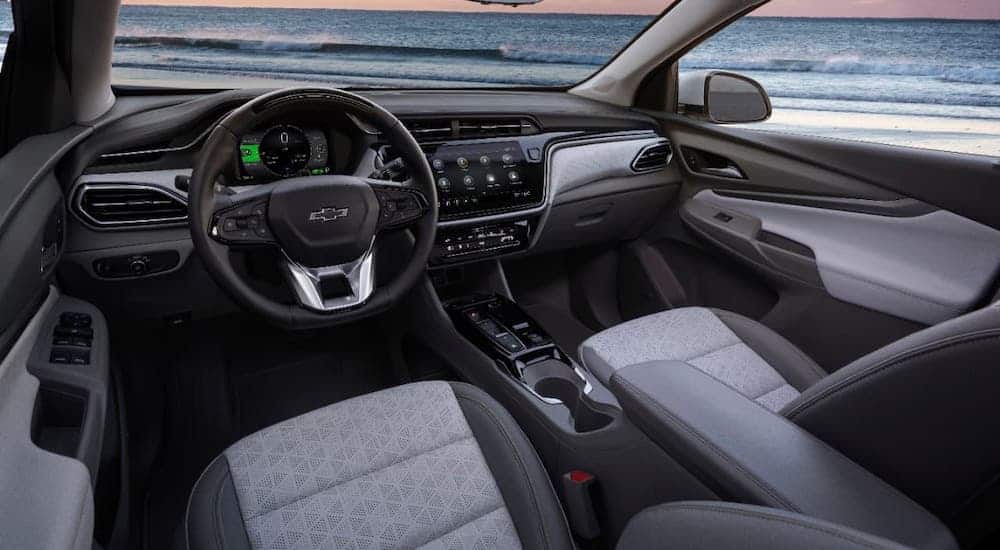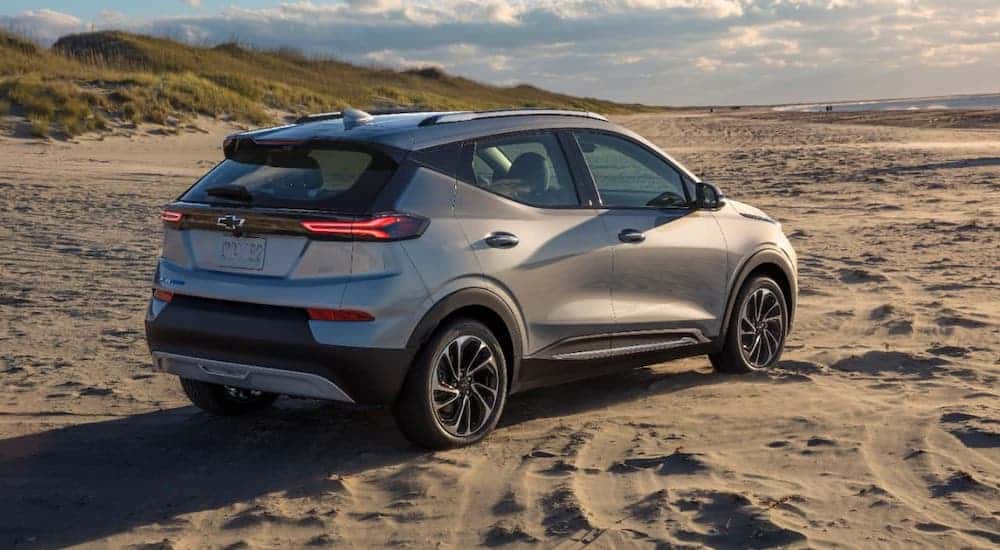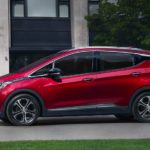Chevy dealers all across the country are abuzz in anticipation of the soon-to-be-released 2022 Chevy Bolt EUV. Why? This “Electric Utility Vehicle” represents the culmination of General Motors’ expansive gains in advanced battery technology, achieved in partnership with several key suppliers. The team set a lofty goal: make EVs accessible for all buyers.
But what exactly does accessible mean? It means recognizing that mainstream buyers aren’t willing to compromise key vehicle characteristics just to adopt the EV lifestyle. They want their EV to look, sound, and feel like a traditional gas or diesel-powered car. These buyers aren’t attracted to the novelty of driving an EV: they are less adaptable to change.
EVs with the same driving characteristics as traditionally-powered cars, trucks, and SUVs deliver in three specific areas: affordable price, extended driving range, and similar levels of performance. Interestingly, it’s these three characteristics that also happen to represent the three main reasons everyday buyers reject EVs in the first place.
We all remember the early Toyota Prius. What comes to mind? Bland styling, underperformance, and a high price tag. Early in its life cycle, buyer profiles were that of early adopters, meaning they were fringe consumers who were willing to try newer technology and were comfortable abandoning tradition. Unfortunately, that set the stage for Prius owners being stereotyped as tree huggers, and the Prius became a laughing stock among performance-loving drivers.
There’s still a small amount of residual ‘uncoolness’ associated with driving a hybrid car or EV, which is the core issue automakers must overcome. How? By building exciting EVs that deliver comparable driving range and performance at a price mainstream buyers can afford. That’s why the new 2022 Chevy Bolt EUV has so many automotive journalists feeling optimistic. It could just revolutionize the EV category.
Affordability
The first and most difficult obstacle automakers face when launching an EV to the mainstream is affordability. Early EVs – like the Tesla lineup – were prohibitively expensive, and as a result, many buyers quickly dismissed them as viable options. In the process of doing so, though, they also rejected the EV category as a whole (regardless of the nameplate), adopting a mindset that the technology was far too expensive and aspirational: that it was reserved for the ultra-wealthy.
Flash forward to today, and the 2022 Chevy Bolt EUV is poised to launch with a starting price tag of under $35,000. That’s well within the affordable range for middle-class Americans, especially because Chevy is picking up the cost to install a free home charging station as part of its launch promotion.
The Bolt EUV is available in three trims: the base LT ($33,995), the mid-range Premier ($38,495), and the sold-out Launch Edition ($43,495). Even at the upper end of the trim range, the Bolt EUV is affordable. Add to that a few factory cash allowances – likely limited-time offers – and state-level incentives and the affordability news gets even better.
The other factor to consider when thinking about price is cost-of-ownership. EVs don’t require gas, nor do they need oil changes. It’s easy to forget this, but all that’s required to keep an EV running is access to an electric outlet. They also need far less scheduled maintenance, most of which is covered under factory warranties. For Chevy EV models, all electric components are covered for up to eight years or 100,000 miles, a tremendous confidence-builder for buyers worried about gambling on newer technology.
Driving Range and Charging
According to an article published on evadoption.com, the average driving range for a gas-powered vehicle in America is roughly 500 miles. Comparatively, they predict the average EV driving range will hit 300 miles by 2022. The article goes on to posit that true mainstream buyers will continue rejecting EV technology until the driving range equals that of gas-powered vehicles.
We’re not sure we agree, and here’s why. Refueling a gasoline vehicle means taking a trip to the gas station, so most people like to be able to drive for a week or more without refueling. In contrast, you can plug in your EV when you get home and have a full battery when you leave in the morning. According to a AAA study, the average driver only drives 29.2 miles a day, so even a short-range EV will be more than enough with regular charging.
The new 2022 Chevy Bolt EUV, for instance, has an estimated driving range of around 259 miles per charge, plenty of range for normal daily driving and commuting, and enough to get pretty far on your long-distance road trip before a charge is necessary. With GM’s upcoming Ultium battery technology, we expect those range numbers to continue increasing at a steady pace over the next few model years.
The only time EV range is really a factor is during long road trips. However, EV manufacturers are already working closely with Federal, state, and local governments to build a national network of charging stations that offer DC Fast Charging, a rapid-charging system that can charge up to 100 miles in around 30 minutes. GM has partnered with EVgo to add over 2,700 fast-charging stations to the network of over 40,000 existing stations over the next five years.
If you think of charging stations as the EV equivalent to gas stations, it makes sense. As the number of EVs on the road increases, so will demand for on-the-go charging. Deciding where to locate these charging stations takes a little forethought since there are different types of chargers – 240-volt, DC fast charging, etc. – and they charge at different rates.
DC fast charging is the fastest way to charge an EV, with a rate of about 100 miles per 30 minutes of charge time for the Chevy Bolt EV. For that reason, they’re usually located near major highways. 240-volt charging takes more time, so strategically positioning non-fast charging stations to top off cars where drivers make lengthier stops (e.g., hotels, restaurants, and mall parking lots) makes far more sense.
Performance
Another area of potential consternation for would-be EV buyers is performance. Historically, the Prius-era hybrid round of alternative-fuel vehicles delivered humdrum performance and left many with a firm opinion that what they gained in environmental responsibility wasn’t worth what they were losing in spirited performance. In short, these early vehicles weren’t that much fun to drive.
The 2022 Chevy Bolt EUV is about to challenge that belief, delivering 200 horsepower and “perky acceleration,” according to the reviewers at Car and Driver. What’s different about electric-powered vehicles is all that power is available instantly, just like flipping a switch. There’s no momentum required to gain access to full-throttle power: it’s there when you need it.
Chevy is also making its driverless Super Cruise feature available on the Bolt EUV. Super Cruise works on compatible highways (there are approximately 200,000 miles of them) via GPS and special LiDAR mapping technology to deliver a truly hands-free driving experience. When engaged, Super Cruise lets drivers take their hands off the wheel and let the car drive itself, g staying centered in its lane and, using adaptive cruise control, a safe distance from the vehicle ahead.
The system first appeared on Cadillac vehicles, and owners report a seamless experience after logging approximately one million miles. It’s a game-changer, especially for distance driving and boring highway commutes. Drivers are still required to keep their eyes on the road (the system will deliver audible reminder alerts if you don’t), but the tedium of keeping the car moving manually disappears.
The Future Is Bright
There is no doubt that this is an era of rapid change in the auto industry. The beneficiary of all this change? You, the car buyer. Manufacturers will continue innovating to meet ever-increasing environmental guidelines, and in the process, they’ll evolve electric vehicles until, eventually, consumer demand evolves with them. If you haven’t taken an EV for a spin, we highly recommend it. You might be surprised not only by how much their driving characteristics mimic those of gas-powered vehicles but by how much you’ll like the unique qualities of an EV – like instant power and near-silent operation. EVs are here to stay; it’s not a matter of if we will get on board, but when.






